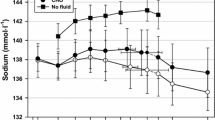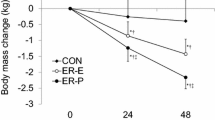Abstract
It has been shown that boys recover faster than men following brief, high-intensity exercise. Better to understand this difference, plasma metabolite concenration, volume, electrolyte concentration [electrolyte], and hydrogen ion concentration [H+] changes were compared in five prepubescent boys [mean age 9.6 (SD 0.9) years] and 5 men [mean age 24.9 (SD 4.3) years] following 30-s, all-out cycling. Blood was collected prior to, at the end, and at the 1st, 3rd and 10th min following exercise. At the 10th min of recovery, the men's lactate concentration was 14.2 (SD 1.8) mmol · l−1 and [H+] was 66.1 (SD 5.9) nmol · l−1, compared with 5.7 (SD 0.7) mmol · l−1 and 47.5 (SD 1.2) nmol · l−1 respectively, in the boys (P < 0.01 for both). The glycerol concentration was higher in the boys at the end of exercise and until the 3rd min of recovery. Plasma volume (PV) decreased more in the men [16.9 (SD 3.0)%] than in the boys [9.4 (SD 2.8)%]. In both groups, [electrolyte] increased after exercise, tending to be higher in the men. Recovery of plasma [electrolyte] and PV started earlier in the boys (1st min) than in the men (3rd min). These findings would support the notion of a lesser reliance on glycolytic energy pathways in children and may explain the faster recovery of muscle power in boys compared to men.
Similar content being viewed by others
References
Alpert BS, Dover EV, Booker DL, Martin AM, Strong WB (1981) Blood pressure response to dynamic exercise in healthy childrenblack vs. white. J Pediat 99:556–560
Bar-Or O (1987) The Wingate anaerobic test, an update on methodology, reliability and validity. Sports Med 4:381–394
Böttger I, Schlein EM, Faloona GR, Knochel JP, Unger RH (1972) The effect of exercise on glucagon secretion. J Clin Endocrinol Metab 35:117–125
Brooke MH, Engel WK (1969) The histographic analysis of human muscle biopsies with regard to fibre types. 1. Adult male and female. 4. Children's biopsies. Neurology 19:221–233, 591–605
Cheetham ME, Boobois LH, Brooks S, Williams C (1986) Human muscle metabolism during sprint running. J Appl Physiol 61:54–60
Cumming GR (1978) Recirculation times in exercising children. J Appl Physiol 45:1005–1008
Delamarche P, Monnier M, Gratas-Delamarche A, Koubi HE, Mayet MH, Favier R (1992) Glucose and free fatty acid utilization during prolonged exercise in prepubertal boys in relation to catecholamine response. Fur J Appl Physiol 65:66–72
Dotan R, Bar-Or O (1983) Load optimization for the Wingate Anaerobic Test. Fur J Appl Physiol 51:409–417
Eriksson BO (1980) Muscle metabolism in children — a review. Acta Paediatr Scand [Suppl] 283:20–27
Eriksson BO, Karlsson J, Saltin B (1971) Muscle metabolism during exercise in prepubertal boys. Acta Paediatr Scand [Suppl] 217:154–157
Eriksson BO, Gollnick PD, Saltin B (1973) Muscle metabolism and enzyme activities after training in boys 11–13 years old. Acta Physiol Scand 87:485–497
Fabiato A, Fabiato F (1978) Effect of pH on the myofilaments and the sarcoplasmic reticulum of skinned cells from cardiac and skeletal muscles. J Physiol (Lond) 276:233–255
Greenleaf JE, Convertino VA, Mangseth GR (1979) Plasma volume during stress in man: osmolality and red cell volume. J Appl Physiol 47:1031–1038
Hebestreit H, Mimura K-I, Bar-Or O (1993) Recovery of muscle power after high-intensity short-term exercise: comparing boys and men. J Appl Physiol 74:2875–2880
Heigenhauser GJF, Jones NL (1991) Bicarbonate loading. In: Lamb DR, Williams ME (eds) Perspectives in exercise science and sports medicine, vol 4. Ergogenics -enhancement of performance in exercise and sport. Brown and Benchmark, Dubuque, pp 183–207
Hodgkin AL, Horowicz P (1959) Movement of Na and K in single muscle fibres. J Physiol (Lond) 145:405–432
Kindermann W, Huber G, Keul J (1975) Anaerobe Kapazität bei Kindern and Jugendlichen in Beziehung zum Erwachsenen. Sportarzt Sportmed 6:112–115
Kowalchuk JM, Heigenhauser GJF, Lindinger MI, Obminski G, Sutton JR, Jones NL (1988) Role of lungs and inactive muscle in acid-base control after maximal exercise. J Appl Physiol 65:2090–2096
Lindinger MI, Heigenhauser GJF, McKelvie RS, Jones NL (1990) Role of nonworking muscle on blood metabolites and ions with intense intermittent exercise. Am J Physiol 258:R1486-R1494
Lindinger MI, Heigenhauser GJF, McKelvie RS, Jones NL (1992) Blood ion regulation during repeated maximal exercise and recovery in humans. Am J Physiol 262:R126-R136
Lindinger MI, Spriet LL, Hultman E, Putman T, McKelvie RS, Lands LC, Jones NL, Heigenhauser GJF (1994) Plasma volume and ion regulation during exercise after low- and high-carbohydrate diets. Am J Physiol 266:R
McKelvie RS, Lindinger MI, Jones NL, Heigenhauser GJF (1992) Erythrocyte ion regulation across inactive muscle during leg exercise. Can J Physiol Pharmacol 70:1625–1633
Medbo JI, Sejersted OM (1990) Plasma potassium changes with high intensity exercise. J Physiol (Lond) 421:105–122
Nakamura Y, Schwartz A (1970) Possible control of intracellular calcium metabolism by [H+]: sarcoplasmic reticulum of skeletal and cardiac muscle. Biochem Biophys Res Commun 41:330–386
Paterson DH, Cunningham DA, Bumstead LA (1986) Recovery O2 and blood lactic acid: longitudinal analysis in boys aged 11 to 15 years. Fur J Appl Physiol 55:93–99
Rotstein A, Bar-Or O, Dlin R (1982) Hemoglobin, hematocrit, and calculated plasma volume changes induced by a short, supramaximal task. Int J Sports Med 3:230–233
Sargeant A (1989) Short-term muscle power in children and adolescents. In: Bar-Or (ed) Advances in pediatric sport sciences, vol 3. Human Kinetics, Champaign, Ill., pp 41–66
Spriet LL, Heigenhauser GJF, Jones NL (1986) Endogenous triacylglycerol utilization by rat skeletal muscle during tetanic stimulation. J Appl Physiol 60:410–415
Stewart PA (1983) Modern quantitative acid-base chemistry. Can J Physiol Pharmacol 61:1444–1461
Zanconato S, Cooper DM, Armon Y (1981) Oxygen cost and oxygen uptake dynamics and recovery with 1 min of exercise in children and adults. J Appl Physiol 71:993–998
Zanconato S, Buchthal S, Barstow TJ, Cooper DM (1993) 31p-magnatic resonance spectroscopy of leg muscle metabolism during exercise in children and adults. J Appl Physiol 74:2214–2218
Author information
Authors and Affiliations
Rights and permissions
About this article
Cite this article
Hebestreit, H., Meyer, F., Htay-Htay et al. Plasma metabolites, volume and electrolytes following 30-s high-intensity exercise in boys and men. Eur J Appl Physiol 72, 563–569 (1996). https://doi.org/10.1007/BF00242291
Accepted:
Issue Date:
DOI: https://doi.org/10.1007/BF00242291




